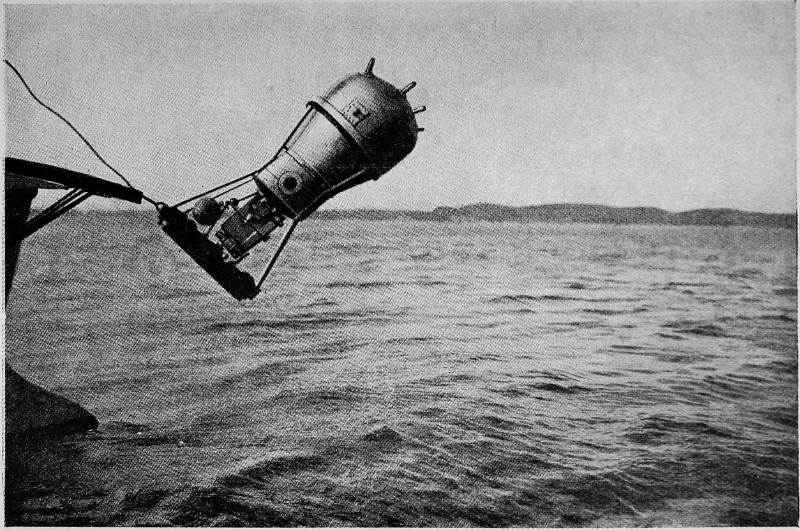submarine mines
if the russo-japanese war was the first to fully demonstrate the value of the explosive mine, the great european conflict has certainly brought this weapon to the forefront in the rapidly growing science of submarine warfare. during the first few weeks of the naval fighting several warships, beginning with h.m.s. amphion, and many merchant vessels representing millions of pounds sterling, were destroyed by these weapons. had it not been for the foresight of the british admiralty in providing a very large fleet of mine-sweepers, aided by seaplanes, there can be no doubt but what the shipping of all countries—neutrals 169and belligerents alike—would have suffered far greater losses.

launching a german trotyl mine.

a german submarine trotyl mine on the deck of a mine-layer.
these mines contain the famous t.n.t., or trotyl explosive.
the indiscriminate scattering of mines across the trade routes, as carried on by germany immediately on the outbreak of war, and before hardly any of the ships at sea belonging to neutral countries could be warned to avoid the zone of operations, has never before been so ruthlessly resorted to by a big civilised power.
the system of defence consists of the mooring of these mines in such positions as to make it almost impossible for hostile ships to pass without either striking or coming within the destructive zone of one or more of them. what are known as floating mines are those set adrift to be washed about by the tide. they explode immediately on being struck by a passing vessel, and, of course, do not discriminate between friend and foe. the systems of destroying hostile mine-fields consist of counter-mining, or placing other mines in the enemy’s field and destroying it by 170their explosion, and by sweeping. the latter method is the one mostly employed in modern warfare. the boats taking part in the sweep place themselves one on each side of the mine-field, and between them hangs a long wire rope, weighted in the centre to keep it well submerged. they then move forward, sweeping the mines to the surface or exploding them harmlessly. it is, however, very dangerous but highly necessary work.
there are two kinds of submarine mines, one is designed to explode on being struck by a passing vessel, and is called a contact mine, and the other is fired from the shore by an electric current, and is known as an observation mine. the explosive principally used is wet gun-cotton or trotyl, owing not only to the safety with which they can be stored and manipulated, but also to the fact that they seldom explode in sympathy with neighbouring mines, requiring to be actually fired. the importance of this will 171be more fully realised when it is remembered that in warfare it is often necessary to explode certain mines over which hostile ships are endeavouring to pass, while leaving others in fairly close proximity intact, ready to repel a second invasion or to destroy ships nearer to them. the actual explosion is caused by an electric current, either from the shore or from a battery in the mine itself, causing the detonation of fulminate of mercury in conjunction with a small priming charge of dry gun-cotton. mines are often laid in a series, connected to a battery on the sea-bed in the centre of the line of defence.
the observation mine is mostly used for defending the approaches to harbours, as an observer on shore can watch the movements of hostile warships and explode each mine when the vessel passes over it. contact mines, on the other hand, are used wherever an enemy’s fleet is likely to pass. they are anchored to the sea-bed by means of a cable and heavy 172weight, and are allowed to float a few feet below the surface. they explode immediately on contact. at times an unscrupulous or demoralised enemy will simply throw a number of these mines overboard and allow them to float at the mercy of wind and tide. they then become a terrible danger to the shipping of all nations, as once they are left unwatched it is extremely difficult to tell with any degree of certainty where they will eventually proclaim their presence by devastating explosions. happily for the whole seafaring world, this method is seldom resorted to, as mines set adrift in this way become a danger to both friend and foe. in the russo-japanese war several ships were destroyed by their own mines.
there are many different kinds of submarine mines, both of the observation and the contact type. some are spherical in shape and others cylindrical. some are moored close down to the sea-bed with a very heavy explosive charge 173(200?500 lbs. of gun-cotton), and have a small buoyant globe floating above them, which, when struck, fires the mine below. others, known as secret-mines, are kept continually moored in the waterways leading to important naval harbours, and are only allowed to rise sufficiently high from the sea-bed to be struck by passing vessels in times of emergency. the type most generally used is, however, the ordinary offensive contact mine, which contains a powerful explosive charge and is anchored in the path of hostile warships. these mines are usually automatically sown in large numbers over a wide area of sea by the mine-laying fleets.
